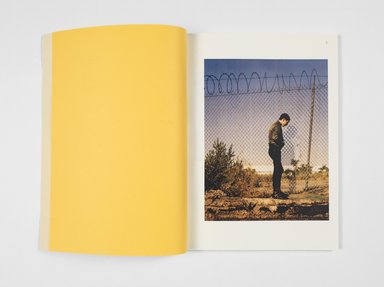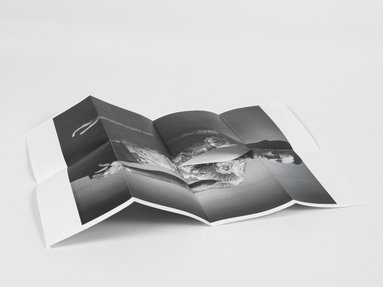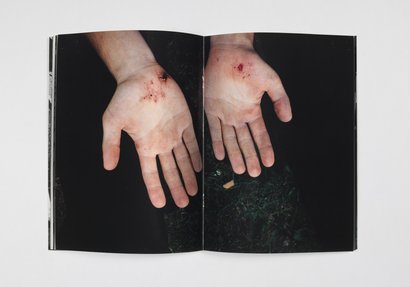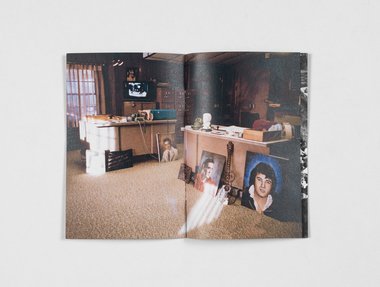This workshop series culminates in participants making their own zines at home, utilizing the free web tool SHRIMP ZINE (co-developed by Laszlo Konrath) and working with Tasweer to create a pop-up exhibition of their zines at M7, Doha, in the closing week of Tasweer 2023. This series is aimed at those with an interest in art, image-making, and a desire to learn the basics in beginning to create their own self-published works.
Zines put the power of personal storytelling into the hands of the maker. This approachable online workshop series touches upon important historical, theoretical and hands-on tutoring in aspects of zine-making and zine culture. During these workshop sessions, we will consider things such as editing, visual flow, and juxtapositions, and experiment with layout and sequencing content to bring a sense of flow and movement to the turning pages, whilst developing a narrative that tells your story.

Images: Andreas Laszlo Konrath
Workshop 1: An Introduction to Zines
26 March 2023
In this first session, we consider the history of zines and the experimental exploration of art and information in zine form. We will consider the physical attributes of paper and discuss its characteristics of grain direction, weight, and texture. Next, we will begin an inquiry into making our first zine with a simple rudimentary structure for beginners - the single-sheet booklet zine that uses just one sheet of 11” x 17” paper. We will then make the most common and traditional multi-page zine structure - the 3-hole pamphlet stitch or saddle stitch zine. Examples of zines and artists that have used related binding styles will be drawn upon to illustrate how these simple structures can be customized by everyone for specific projects and integrated within a specific concept the participant may be working toward.
Workshop 2: Utilizing SHRIMP ZINE
09 April 2023
In our second session, we are introduced to SHRIMP ZINE, discussing its use as an online zine-making tool to be used to prototype and test quick narrative ideas and to think strategically about the photos, images, and photo albums already available to us on our mobile devices and in the Cloud. After a quick SHRIMP ZINE tutorial, the workshop group will produce a zine together. We will draw links to music, particularly genres like hip-hop, rap, and electronic dance music that set precedents for how we creatively use sampling, remixing and mash-ups to create new culture.

Workshop 3: Developing our Zines Further – Editing + Sequencing
16 April 2023
The third session further investigates zine structures and variations and how it is used as a vehicle to express ourselves. While we continue to develop our ideas and find our own language in the zine form, we will ask ourselves how we feel about the projects we are creatively pursuing – are they a true representation of our intention? If not, what shall we do differently?
Workshop 4: Next Steps – Layout + Colophon
30 April 2023
In this session, we look at the orientation of our zines and introduce possibilities of various interventions to the pages and structure of our zines that physically manifest and add to our concept and narrative. We will continue to embrace the zine format and paper for all its potential, expand and stretch the possibilities, challenge ourselves to continue to see in new ways and maximise the material and sculptural qualities of our zines. We continue looking at different ways to construct our zines and focus on some simple ways we can create a dynamic relationship between our text block and our cover stock. This session will also discuss applying any text elements to our zines – a title, any information we want to add, or perhaps a colophon/Impressum page, referencing a selection of zines that incorporate text and typography in dynamic ways.

Workshop 5: Other Possibilities, Covers & Finalizing Your Zines
5 May 2023
In our final session together, we will discuss and investigate with examples a few different styles of cover-making, cover possibilities, combinations, and variations (dust jackets, interactive layers, interventions, gatefolds, 2-fold cover, belly bands, colophon page) to support your zine’s interior. We will also delve into other formats of a self-publishing art practice, for example, sketchbooks, scrapbooks, studio logs, research, collections, archiving, the artist’s book, books as objects, and books as an exhibition form.
Before the end of the session, we will ensure to give time for each participant to vocalize their thoughts regarding the zines they have produced in these sessions, and how they hope to continue using some of these skills in their own creative practice. We keep this part of the session as an open conversation as much as possible, making space for anything we have not covered or any specific questions the group might have. Lastly, we will touch upon how a zine-maker is often also the publisher who manages the costs, labor, and time of making their zine, as well as the distribution, handling customer networks, archiving, documentation, promotion, packing, shipping, and all retail duties all rolled into one. Let’s discuss strategies of how to multitask all these roles and responsibilities for the best success of disseminating, sharing and even selling your zines in the world.
Pop-up exhibition at M7, Doha:
To mark the workshop group’s ‘graduation’, Tasweer will work with Andreas to create a pop-up exhibition of the zine concepts created by the workshop group that will be open for public viewing in the closing week of Tasweer’s 2023 festival, in M7, from 13 – 20 May 2023.
Get ready with the required equipment:
- Around 20x Sheets of Paper (both 8 1/2" x 11" & 11" x 17"), any weight or colour. Mix and match are good!
- A Bone Folder
- A Pencil & Ruler (and/or a straight edge)
- An Awl (or a pushpin)
- Needle & Thread (regular thread is fine, but if there are book-binding thread and needles, that's great!)
- Two Binder Clips
- Scissors and/or X-Acto Blade (and a safe surface to cut on like a cutting mat)
- Access to a device different from the one used for the Zoom meeting
If you have any questions or need any help with putting together your equipment, reach out to us at eventstqa@tasweer.qa

About Andreas Laszlo Konrath
Andreas is a photographer and artist educator and utilizes the zine format as a vehicle for many projects, additionally publishing with other artists citing community building, exchange, and collaboration as a key inspiration and motivator. Andreas' zines have been archived in collections at the ICP Triennial, The Getty Research Institute, The Metropolitan Museum of Art Library, MoMA Library & The Yale University Library. Andreas contributes regularly as a visiting artist to FIT, ICP, Parsons School of Design at The New School, Pratt Institute, Red Hook Labs & SVA, and has organized zine workshops for Fondation Louis Vuitton, Gavin Brown’s enterprise, Penumbra Foundation, Red Hook Community Justice Center & Tasweer Photo Festival Qatar.
Keeping a connection to community, Andreas recently co-developed a progressive web app – ‘SHRIMP ZINE’ – that allows users to create zines for free on their smartphones, bringing a new creative and collaborative access point to digital natives.
About SHRIMP ZINE
SHRIMP ZINE is a progressive web app developed to help young digital natives to make zines for free on their smartphones. This is intended to be a communal creative tool that takes images that live in the digital sphere and help those using the app to merge them into an object that can be printed out, shared, and exchanged. Created to promote the art of zine-making and explore the possibilities of the digital and the physical coming into contact with one another, as well as engaging in public discourse and world-building using the vessel of the zine and printed material as a catalyst to do this work. SHRIMP ZINE exists to consider how to build bridges between people and allows for new and exciting forms of tangibility and connectivity.